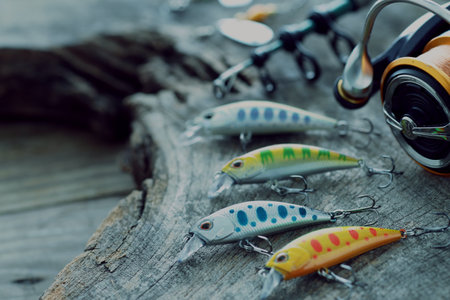Understanding the Basics: Why Tackle Storage Matters
When it comes to fishing, keeping your gear in top condition isn’t just about being organized—it’s about making sure every cast counts. Proper storage for hooks, weights, and lures can make or break your day on the water. In the unpredictable American outdoors, moisture is a real threat, especially if you’re fishing in humid lakes down South or misty mornings up North. Left unchecked, even a little water can lead to rusted hooks and corroded weights, which not only weakens your tackle but can also ruin your favorite lures. Tangling is another common headache; nothing’s more frustrating than reaching into your box and pulling out a mess of treble hooks and line. That kind of hassle wastes time and can cost you fish when every second matters. By understanding why smart storage matters—from preventing rust to avoiding tangles—you’ll be setting yourself up for smoother trips and better stories at the end of the day.
2. Choosing the Right Tackle Box or Organizer
Finding the perfect tackle box or organizer is a game-changer when it comes to keeping your hooks, weights, and lures safe and easy to reach. Across the U.S., anglers use a variety of storage solutions tailored to their fishing habits, whether they’re casting from a quiet lakeshore or heading out on a weekend bass boat adventure. Here’s a look at the most popular options and how to pick the best one for you.
Popular Types of Tackle Storage in the U.S.
| Type | Description | Best For |
|---|---|---|
| Hard Tackle Boxes | Durable plastic or metal boxes with multiple trays and compartments. Classic design, often with a handle for easy carrying. | Shore fishing, organized home storage, anglers who value durability. |
| Soft Tackle Bags | Made from fabric, featuring adjustable dividers and plenty of pockets. Lightweight and flexible, often include shoulder straps. | Mobile anglers, kayak fishers, those who pack light and value portability. |
| Modular Storage Systems | Stackable or customizable boxes (like utility trays) that fit inside larger bags or boat compartments. | Boat anglers, tournament fishers, anyone who wants to swap out gear quickly. |
Tips for Picking Your Ideal Tackle Organizer
- Consider Your Fishing Style: Are you hiking into remote streams or do you fish from a boat? Match your organizer’s size and weight to your typical outing.
- Pockets & Compartments: More isn’t always better—choose a box with enough dividers to keep things sorted without becoming cluttered.
- Water Resistance: Look for waterproof seals or quick-dry materials if you’re often in wet conditions.
- Ease of Access: Quick-open latches or clear lids help you grab what you need without digging around.
- Room to Grow: Pick a system that lets you add more trays or pouches as your collection expands.
The Bottom Line
No matter where your fishing takes you—from city ponds to sprawling lakes—choosing the right tackle box or organizer makes every trip smoother. Take time to find one that fits your routine, protects your gear, and keeps everything ready for your next big catch.

3. Organizing Hooks, Weights, and Lures Effectively
If you’ve ever found yourself digging through a tangled mess of tackle while the fish are biting, you know how important organization can be. Keeping your hooks, weights, and lures sorted isn’t just about neatness—it’s about making your time on the water more enjoyable and productive. Here are some tried-and-true tips for arranging your tackle so everything stays in top shape and easy to reach.
Use Clear Labeling Systems
Start by labeling every container and compartment. Whether you’re using a classic tackle box or a modern modular system, clear labels help you find exactly what you need without second guessing. Go for waterproof labels or use a label maker with laminated tape so everything stays legible even after a splash or two. For extra efficiency, color-code labels based on lure type or target species—this little touch can save precious minutes when you’re on the move.
Small Containers Make a Big Difference
When it comes to storing small items like hooks and split shot, nothing beats individual containers. Tiny plastic boxes, pill organizers, or even recycled mint tins work wonders for keeping things separated and rust-free. If you’re into DIY, try dividing larger boxes with removable inserts—this lets you customize storage as your collection grows or changes with the seasons.
Keep Frequently-Used Items Handy
No one wants to dig for their favorite jig head when the bass are biting. Set aside a special spot in your main tray or front pocket of your tackle bag for go-to lures and terminal tackle. Magnetic strips can also be handy for quick access to pliers, scissors, or even certain hooks—just make sure they’re strong enough to hold up during bumpy boat rides.
Pro Tip: Rotate Your Tackle Seasonally
As fishing conditions change throughout the year, so should your tackle organization. Before each trip—or at least every season—review what’s in your kit. Swap out rarely used items for those best suited to current conditions, and give everything a quick check for rust or damage while you’re at it.
A Place for Everything
The best way to protect your gear is to give each piece its own home. With smart labeling, dedicated containers, and thoughtful arrangement, your hooks stay sharp, weights stay put, and lures stay tangle-free—leaving you more time to focus on the fun part: catching fish!
4. Protecting Your Gear from Water, Rust, and Sun
Nothing ruins a great day of fishing like discovering your favorite lures or sharpest hooks have rusted over or been sun-bleached. To keep your tackle box fresh and ready for the next trip, you’ll want to protect your gear from moisture, corrosion, and those sneaky UV rays. Here are some practical ways to keep your hooks, weights, and lures in top shape:
Dry Before You Stow
After every outing, take a moment to spread out your gear on a towel or mesh rack and let it air dry completely. Even a little leftover water can lead to rust or mold. If youre in a hurry, use a clean cloth to wipe down everything before packing up.
Add Some Extra Protection
For extra defense against moisture and corrosion, consider using desiccant packs and rust inhibitors in your tackle boxes. These tools soak up humidity and keep the inside of your box dry—just what you need after a humid morning on the lake or river.
| Protection Method | How It Helps |
|---|---|
| Desiccant Packs (Silica Gel) | Absorb excess moisture inside tackle boxes |
| Rust Inhibitor Tabs | Create an anti-corrosive environment for metal gear |
| UV-Resistant Tackle Boxes | Shield contents from sun damage and fading |
| Proper Drying Techniques | Minimize risk of mold, rust, and odors |
Keep the Sun at Bay
The American sun can be relentless, especially during summer fishing trips. Store your tackle box in the shade whenever possible—never leave it exposed in the back of a pickup or under direct sunlight for hours. Using UV-resistant storage containers also helps prevent plastics from becoming brittle and colors from fading.
Tackle Box Tips for Lasting Gear
- Rotate desiccant packs regularly so they stay effective.
- Choose clear boxes with UV protection if you like to see your lures at a glance.
- If any hook or lure does start to show signs of rust, remove it immediately—rust spreads fast!
- A quick rinse with fresh water (especially after saltwater trips), followed by thorough drying, will add years to your gear’s life.
The Bottom Line
Your collection of hooks, weights, and lures is an investment in future adventures. With just a few simple habits—drying thoroughly, adding moisture-absorbing packs, using rust inhibitors, and keeping sun exposure in check—you’ll make sure every cast counts on every trip.
5. On-the-Go Tips: Staying Organized at the Lake or on the Boat
If you’re an angler who loves chasing bass at dawn or casting from a kayak at sunset, keeping your hooks, weights, and lures organized while on the move is key to a smooth day on the water. Here’s how to stay on top of your game without sacrificing precious fishing time.
Choose Smart Portable Organizers
When you’re hopping from shore to boat, go for compact tackle boxes with customizable compartments. Many American anglers swear by soft-sided tackle bags with modular trays—they fit easily under seats and can be swapped out based on what species you’re targeting that day. Look for waterproof cases with tight seals to keep your gear rust-free even if things get splashy.
Gear Caddies for Easy Access
A good gear caddy or utility belt is a game-changer when you want everything right at your fingertips. Clip-on pouches or magnetic holders let you keep essentials like pliers, extra hooks, and split shot within arm’s reach. Some anglers use small, clear zippered pouches for quick lure changes—just toss them in your backpack or attach them to your belt loop.
Quick-Change Solutions for Lures
Time is of the essence when the bite is hot! Pre-rigging a few rods with different lures saves minutes fumbling through boxes. Also, try using carabiner clips or split ring organizers to group similar lures together. This way, swapping out a crankbait for a spinner takes seconds—not minutes—so you never miss a feeding frenzy.
Stay Tidy—Even When Things Get Messy
Bring along resealable plastic bags or small containers for used hooks and soft plastics. Not only does this prevent clutter, but it keeps sharp points from snagging your fingers or gear. At the end of the day, a quick wipe-down and reorganization session will keep your equipment ready for the next adventure—and ensure nothing gets left behind in the boat or on the dock.
6. DIY Solutions and Home Storage Hacks
Sometimes, the best way to keep your hooks, weights, and lures organized doesn’t require a trip to the store—just a little creativity at home. Repurposing everyday items not only saves money but also adds a personal touch to your fishing setup. For instance, mason jars make excellent storage containers for small tackle like split shot or swivels. Their clear glass lets you see exactly what’s inside, and they’re sturdy enough to toss in your gear bag or line up on a shelf in the garage.
Another favorite hack among American anglers is using magnetic strips—like the kind you’d find in a kitchen for knives—to hold hooks and jig heads securely. Simply mount a strip on the wall above your workbench or inside a cabinet door and you’ll have instant, visible access to your sharpest tools without digging through boxes.
If you’ve got an old muffin tin lying around, don’t toss it! These are perfect for sorting different sizes of weights or beads. Each cup acts as its own compartment, keeping everything separated and easy to grab when you’re packing for your next fishing adventure.
Plastic pill organizers and bead storage cases from craft stores also make excellent, budget-friendly options for storing smaller lures and terminal tackle. Label each section with a permanent marker so you know exactly where everything is at a glance. This way, nothing gets lost in the shuffle between trips.
Finally, don’t overlook sturdy toolboxes or tackle trays that can be customized with foam inserts or dividers. By adapting these common household items, you’ll develop a storage system that fits your unique collection—and makes gearing up for those spontaneous after-work fishing runs quick and painless.


